McARTHUR-TYPE COMPOUND PHASE CONTRAST MICROSCOPE OF NIKON
MODEL: HP MICROSCOPE
DATE: c. 1968
MAKER: NIKON
SIGNED: Nikon, JAPAN
SERIAL NUMBER: 44946
DESCRIPTION
This microscope is of the McArthur type with a folded compact
optical path for inverted slide viewing. The body is quite similar to a
Nikon 35 mm camera body.
Light enters from above, either directly or by reflection. The
mirror can be directed to admit an external light source or light from
the built-in bulb projecting at an angle from the top of the condenser
arm. The mirror has not only an adjustable angle, but also can rotate,
with a stop for the front-most position where it can be directed to
reflect the light from the built-in source.
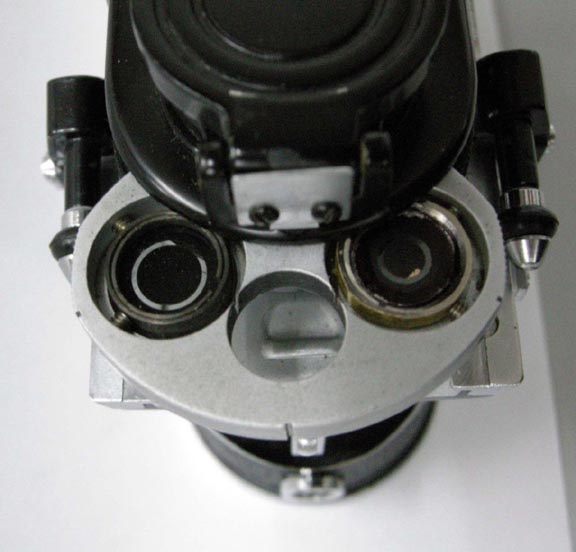
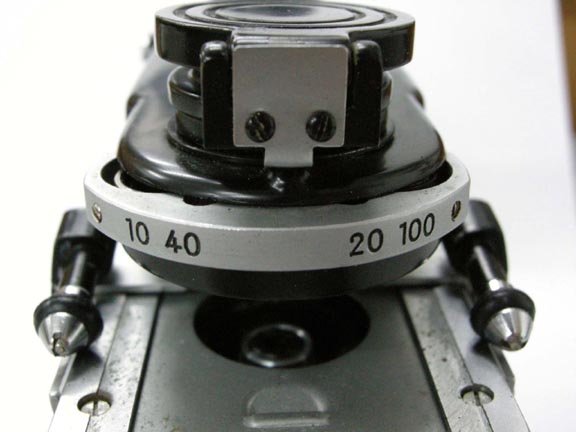 The phase rings,
which are permanently installed and factory aligned, are changed by
rotating the elliptical housing. One ring is labeled for use with the
10X or 40X objective, the other for the 20X or 100X. In addition, a
neutral position has no phase ring, allowing brightfield illumination.
The phase rings,
which are permanently installed and factory aligned, are changed by
rotating the elliptical housing. One ring is labeled for use with the
10X or 40X objective, the other for the 20X or 100X. In addition, a
neutral position has no phase ring, allowing brightfield illumination.
There is no iris diaphragm on this HP (handheld phase) model. Beneath
the phase rings is a condensing lens that can be changed from a low
power to high power by sliding a small knob on the arm forward or
backward. Unlike the original McArthurs, the arm of this microscope on
on a hinge and can therefore be lifted up to give easy access to the
stage.
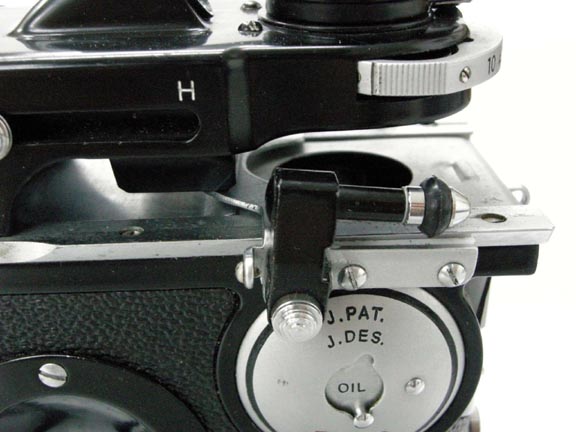 The stage is of the 'traversing' or 'gliding' type; not quite a full
mechanical stage, but allowing minute movements of the slide. The stage
plate moves forward or backward on greased rails, while left-right
movement of the slide is under two small rubber rollers which are held
on the slide by tiny springs. These tiny springs are exposed, and can
easily to lost if the operator is unaware and/or careless. At least one
known example of this microscope had a geared adjustment for these
rubber rollers making the right-left movement fully mechanical. There
is a thin plate below the stage rails which can be slid out to better
access the objectives. It also had a thin plastic cover to completely
protect the inside mechanism when not in use.
The stage is of the 'traversing' or 'gliding' type; not quite a full
mechanical stage, but allowing minute movements of the slide. The stage
plate moves forward or backward on greased rails, while left-right
movement of the slide is under two small rubber rollers which are held
on the slide by tiny springs. These tiny springs are exposed, and can
easily to lost if the operator is unaware and/or careless. At least one
known example of this microscope had a geared adjustment for these
rubber rollers making the right-left movement fully mechanical. There
is a thin plate below the stage rails which can be slid out to better
access the objectives. It also had a thin plastic cover to completely
protect the inside mechanism when not in use.
Unlike the original McArthur design, where objectives are
changed by sliding their single rectangular housing in or out, the
Nikon uses a rotating turret which rotates around a horizontal axis via
a control accessed from the front of the instrument. This turret holds
up to three special miniature objectives. There is a slot on the side
of the microscope which facilitates placing a drop of oil on the oil
immersion objective before it is rotated to contact with the slide.
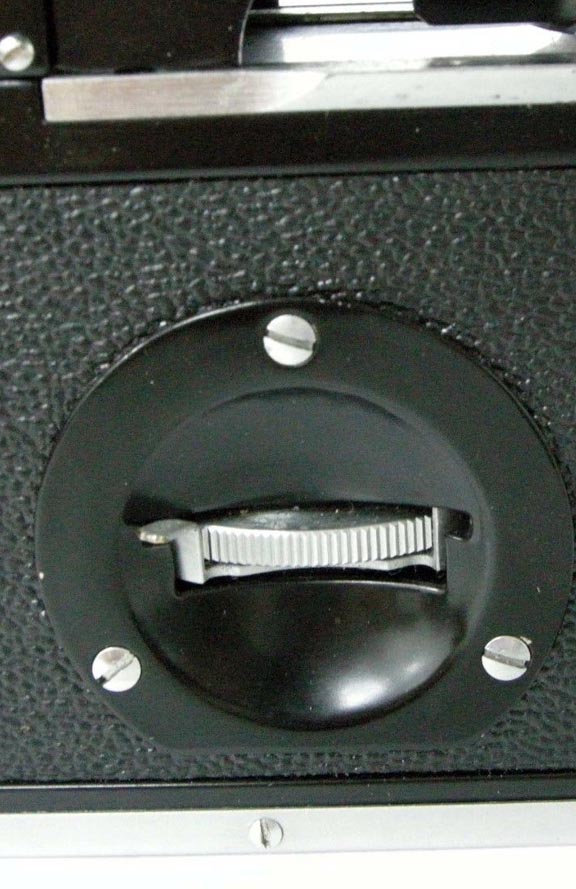 This microscope, because of the inverted slide position,
insures the surface of the slide is always in the same plane,
regardless of slide thickness; just like the original McArthur model,
this eliminates the need for coarse focus. Unlike the original McArthur
models, the focusing control is oriented with its axis of rotation in
the vertical plane. This focus control is not quite as precise as the
McArthur design. There is a lever underneath it, which when slid to the
right locks the fine focus arm in a position for traveling.
This microscope, because of the inverted slide position,
insures the surface of the slide is always in the same plane,
regardless of slide thickness; just like the original McArthur model,
this eliminates the need for coarse focus. Unlike the original McArthur
models, the focusing control is oriented with its axis of rotation in
the vertical plane. This focus control is not quite as precise as the
McArthur design. There is a lever underneath it, which when slid to the
right locks the fine focus arm in a position for traveling.
As in the original design, the light passed through the objective
enters a prism and is reflected up at the back of the instrument. The
eyepiece is of standard size, however it has a threaded area just under
its upper half to allow it to be secured to the eyepiece housing
without the worry it would fall out if the microscope was not in an
upright position. The chrome-plated sleeve which houses the eyepiece is
removable.
In front of the eyepiece is the battery compartment. The
door to the batteries is one of the few plastic parts. A knurled screw
is used to lock the battery compartment. The bulb is housed in the top
of the arm at an upward angle. The switch is at the bottom of the right
side of the microscope near the front. On the front of the instrument,
near the bottom is a fitting for external power; this recepticle is
identical to many which are used for an external flash unit for 35 mm
cameras. The quality of the optics of this microscope are superb.
HISTORY
This inverted portable compact microscope design originated with John
McArthur in the 1930's and was repeatedly improved for the next sixty
years or more. The final version of the original McArthur microscope
was made by Kirk & Sons about 1993. A discussion of this type of instrument and its history along with other examples and references is found on this website.
DISCUSSION
This is the phase contrast version of the
famous Nikon H inverted McArthur-type microscope. The phase contrast
version is quite a bit less common than the brightfield version.
Because the phase ring adjustment is performed at the factory,
condensers for phase contrast vs. other applications are not
interchangeable. Although there is a brightfield setting (no phase
ring) on this condenser, there is no iris diaphragm. This contrasts
with the Cooke-McArthur, where the condensers are interchangeable and
the phase ring alignment does not need to be adjusted in the microscope
because of a finer mechanism locating the objectives under the light
path. Other differences include the different mechanisms for changing
objectives (turret instead of sliding rails), and the ability to raise
the arm of the Nikon. Although the electrical components are all
integral to this model, the original McArthurs have a removable
electric illumination unit. Taking all the differences and options into
consideration, I personally prefer the Cooke-McArthur.
I would like to thank Dr Yuval Goren for allowing me to reproduce
his images of my Nikon HP here, and for his kindness in selling me this
microscope.
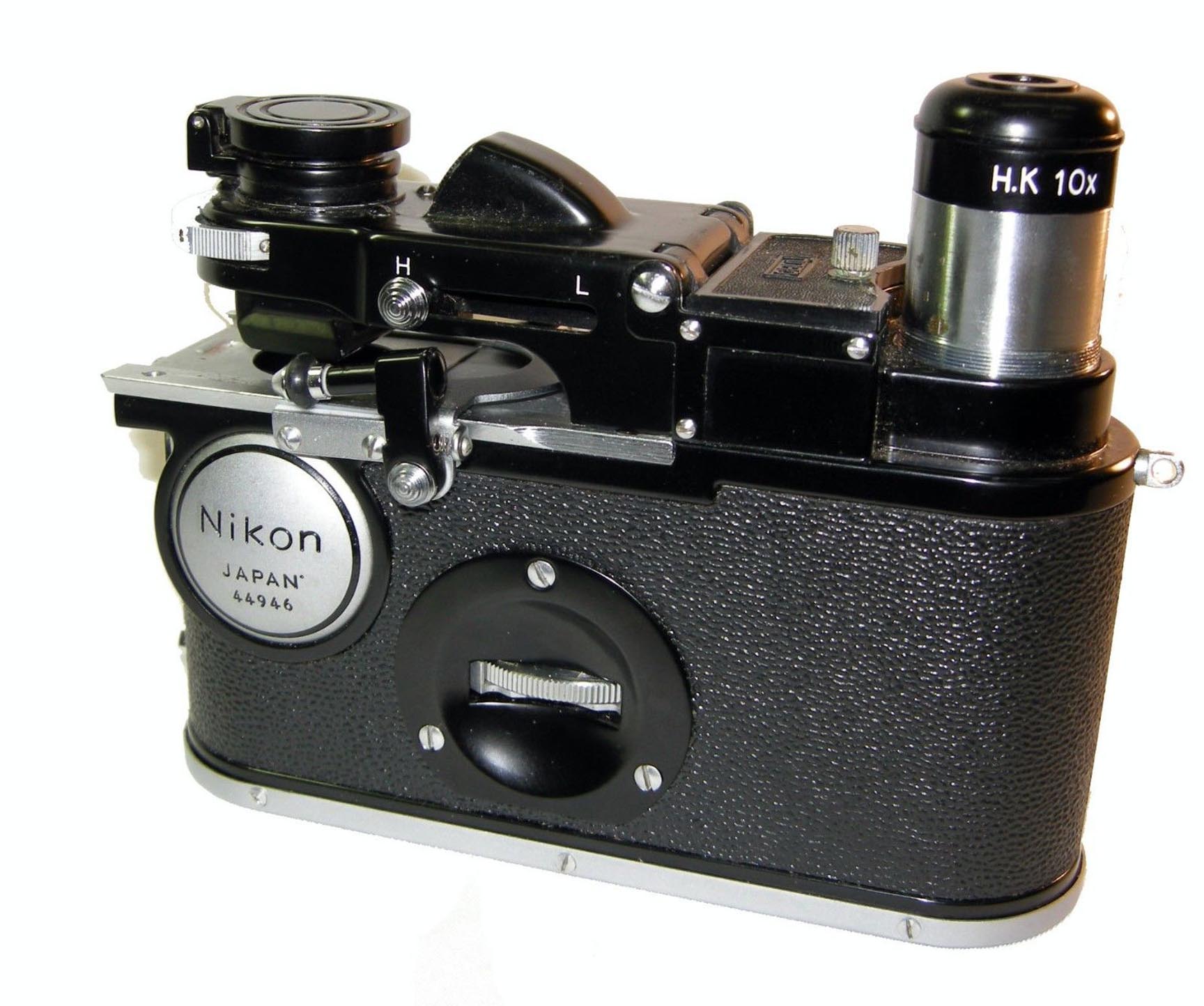
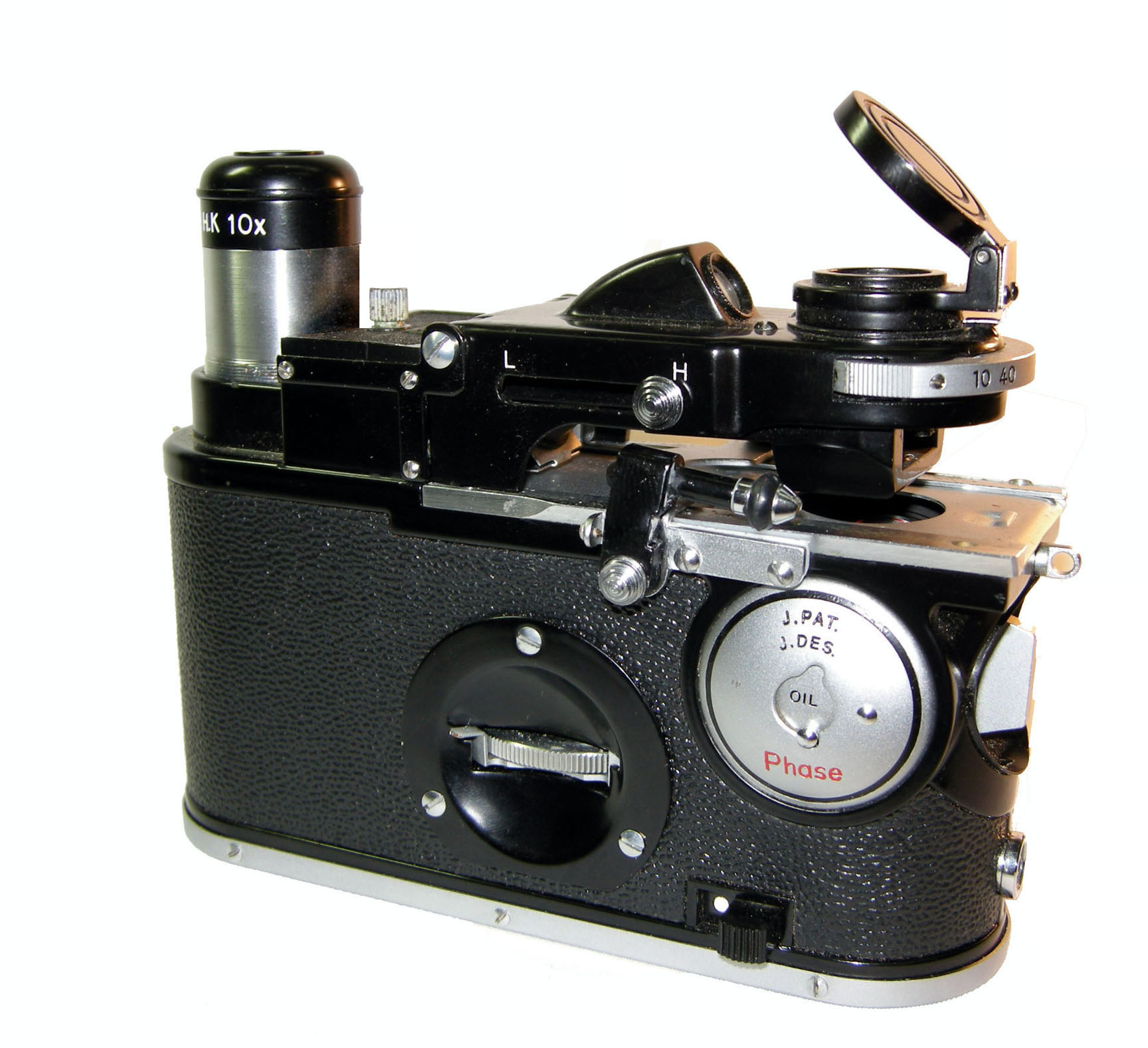
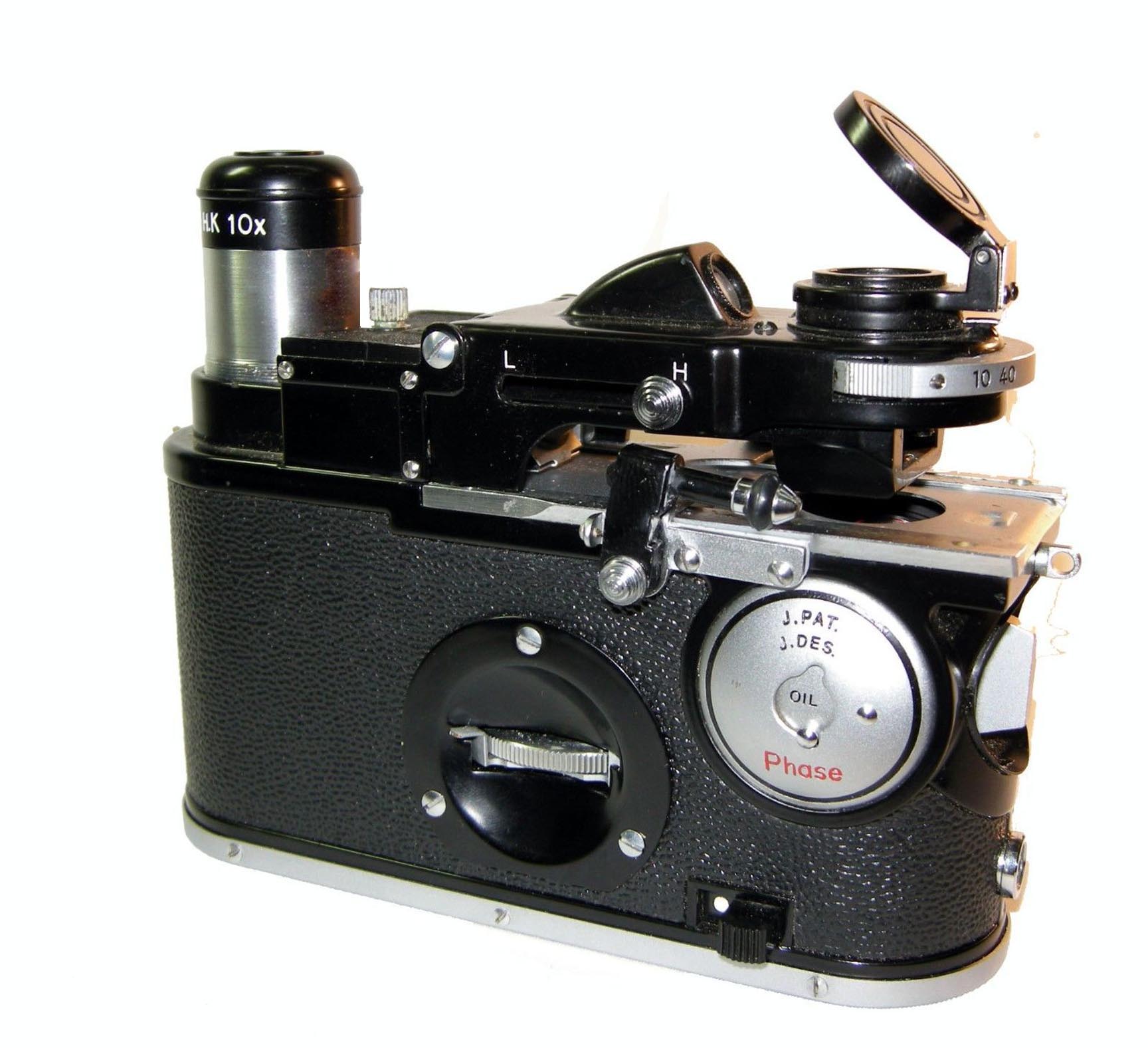





 The phase rings,
which are permanently installed and factory aligned, are changed by
rotating the elliptical housing. One ring is labeled for use with the
10X or 40X objective, the other for the 20X or 100X. In addition, a
neutral position has no phase ring, allowing brightfield illumination.
The phase rings,
which are permanently installed and factory aligned, are changed by
rotating the elliptical housing. One ring is labeled for use with the
10X or 40X objective, the other for the 20X or 100X. In addition, a
neutral position has no phase ring, allowing brightfield illumination.  The stage is of the 'traversing' or 'gliding' type; not quite a full
mechanical stage, but allowing minute movements of the slide. The stage
plate moves forward or backward on greased rails, while left-right
movement of the slide is under two small rubber rollers which are held
on the slide by tiny springs. These tiny springs are exposed, and can
easily to lost if the operator is unaware and/or careless. At least one
known example of this microscope had a geared adjustment for these
rubber rollers making the right-left movement fully mechanical. There
is a thin plate below the stage rails which can be slid out to better
access the objectives. It also had a thin plastic cover to completely
protect the inside mechanism when not in use.
The stage is of the 'traversing' or 'gliding' type; not quite a full
mechanical stage, but allowing minute movements of the slide. The stage
plate moves forward or backward on greased rails, while left-right
movement of the slide is under two small rubber rollers which are held
on the slide by tiny springs. These tiny springs are exposed, and can
easily to lost if the operator is unaware and/or careless. At least one
known example of this microscope had a geared adjustment for these
rubber rollers making the right-left movement fully mechanical. There
is a thin plate below the stage rails which can be slid out to better
access the objectives. It also had a thin plastic cover to completely
protect the inside mechanism when not in use.
 This microscope, because of the inverted slide position,
insures the surface of the slide is always in the same plane,
regardless of slide thickness; just like the original McArthur model,
this eliminates the need for coarse focus. Unlike the original McArthur
models, the focusing control is oriented with its axis of rotation in
the vertical plane. This focus control is not quite as precise as the
McArthur design. There is a lever underneath it, which when slid to the
right locks the fine focus arm in a position for traveling.
This microscope, because of the inverted slide position,
insures the surface of the slide is always in the same plane,
regardless of slide thickness; just like the original McArthur model,
this eliminates the need for coarse focus. Unlike the original McArthur
models, the focusing control is oriented with its axis of rotation in
the vertical plane. This focus control is not quite as precise as the
McArthur design. There is a lever underneath it, which when slid to the
right locks the fine focus arm in a position for traveling. 
